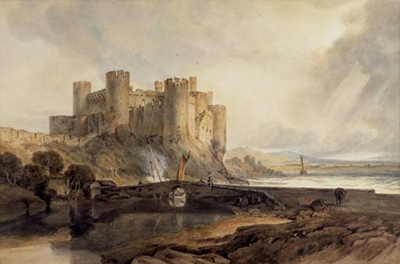Conway (or Conwy) Castle is a worthy subject for a painting or, in modern times a photograph, having been built in the 1200s and being in remarkably good repair.
So well preserved is it, that UNESCO have declared it to be one of 'the finest examples of late 13th century and early 14th century military architecture in Europe'.
It is, therefore, fitting that the castle has been immortalised by one of England's finest painters, not once, not twice, but many times.
Joseph Mallord William Turner was born in 1775 and demonstrated his artistic talent from a very young age.
He travelled extensively around England and Wales, and would often revisit the site of previous paintings and produce a new piece, sometimes taken from the close to the same place as before.
This is the case with this wonderful painting of Conway Castle created in 1800. Turner has so accurately captured the movement of the clouds and the sunlight breaking through after a rain storm that one can practically sense the freshness in the air.
Not for nothing is Turner called 'the master of light' – his paintings show a keen appreciation for the fleeting beauty of clouds and sunshine and their constantly shifting interplay.
Over his lifetime, Turner's painting style changed from minutely detailed landscapes and urban scenes, overlooked by grand atmospheric skies to a focus on the skies themselves, the arguable subjects of the paintings – the landscape and scenery – becoming amorphous and transparent, thinly applied oil paints declaring the unimportance of man when compared to the might of Nature.
This painting was created when Turner was at the peak of his powers and shows, in lovingly rendered detail, not only the castle, the bridge, the trees planted to protect the gate house built at the far end of the bridge, and of course, the sky, but also the rocks washed almost smooth by the tide, a donkey or horse standing on the beach, patiently awaiting the return of its owner (possibly Turner himself?) and the tall stumps of dead trees, possibly cut down to make room for the bridge, possibly harvested for ship repairs.
By way of comparison, Turner's previous painting of Conway Castle, from 1798, shows a wilder scene – the civilising bridge that forms the focal centrepiece of this painting is almost out of sight, and the very sea seems to be in uproar with waves threatening to sweep aside rocks, trees; even the very cliffs themselves.




